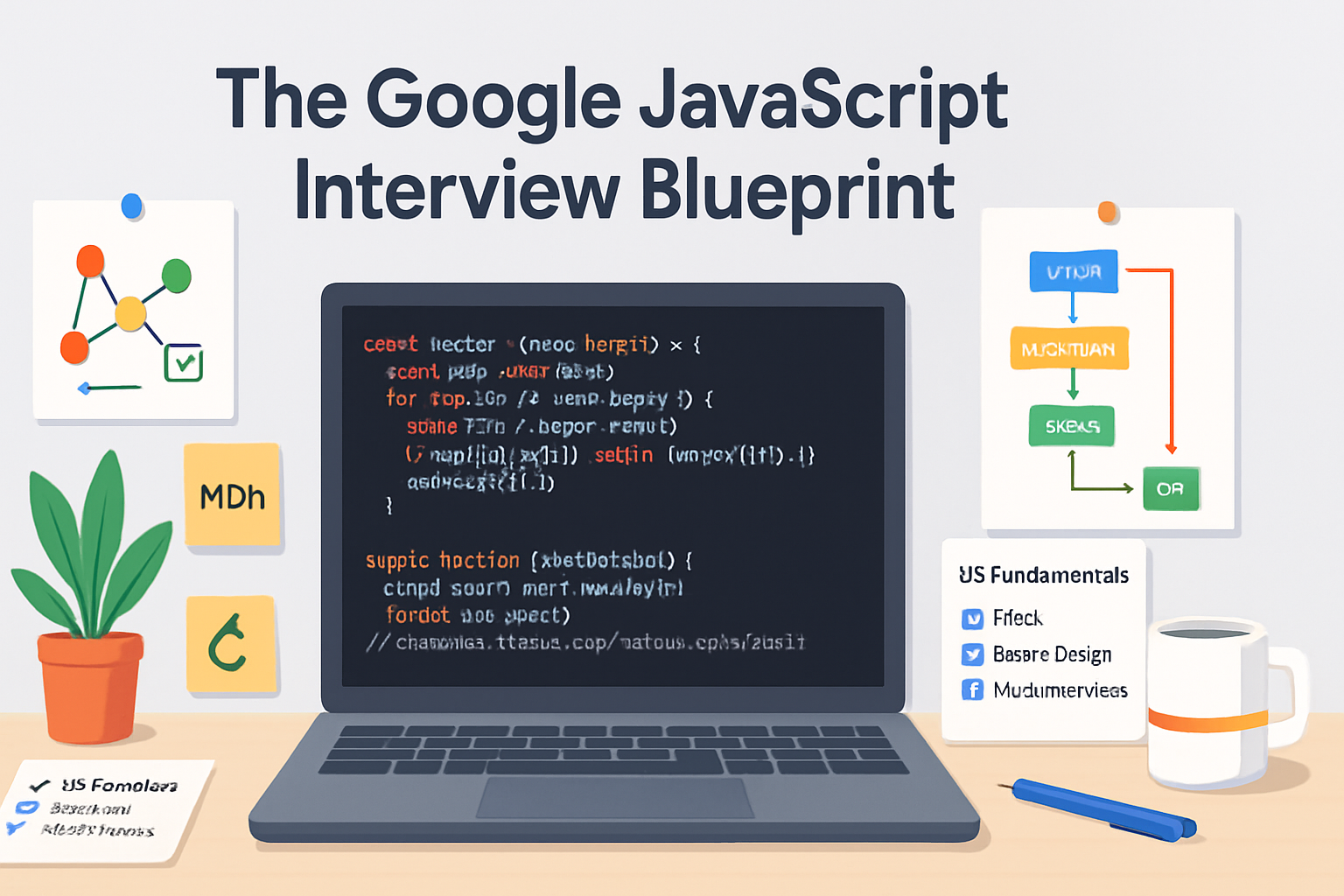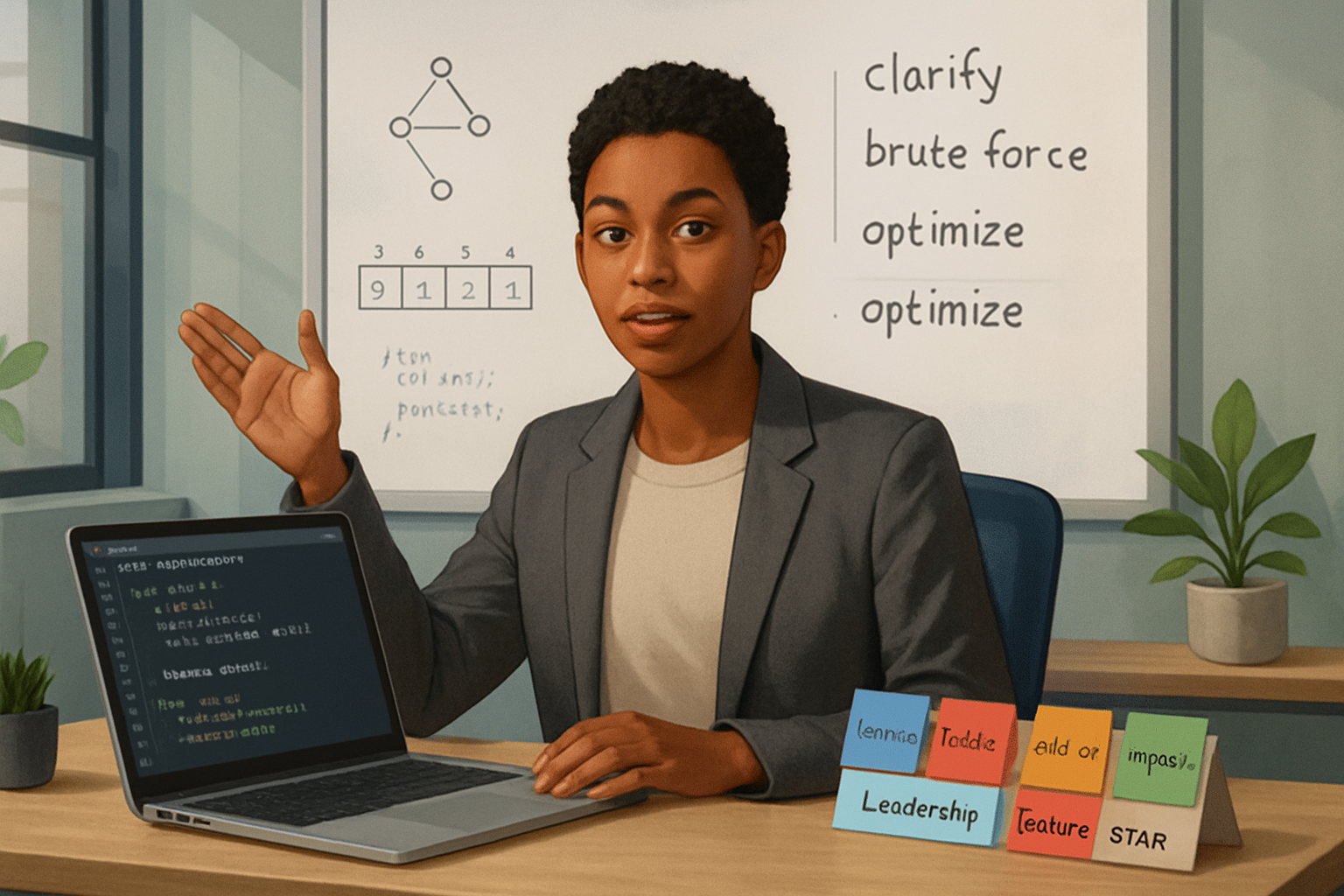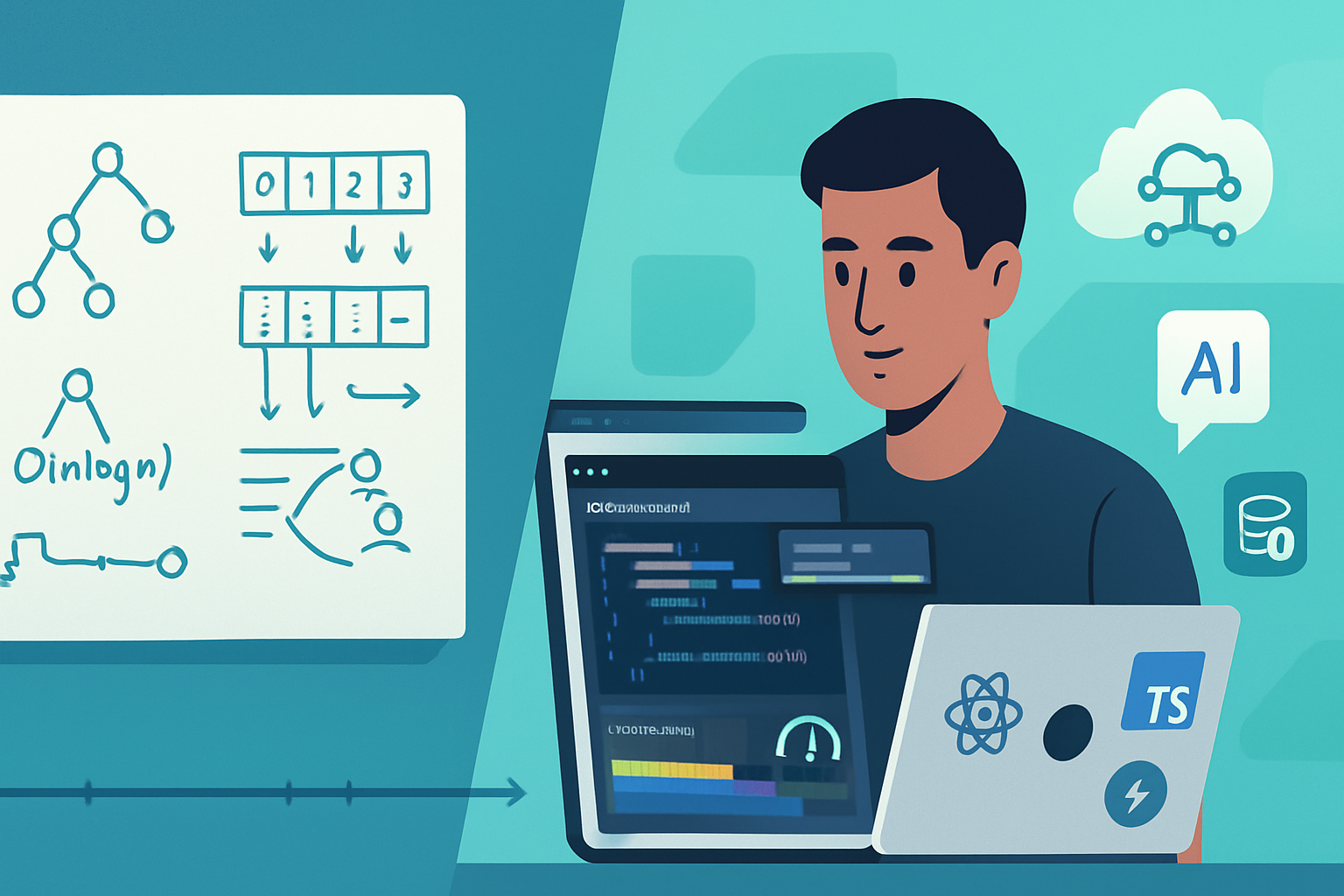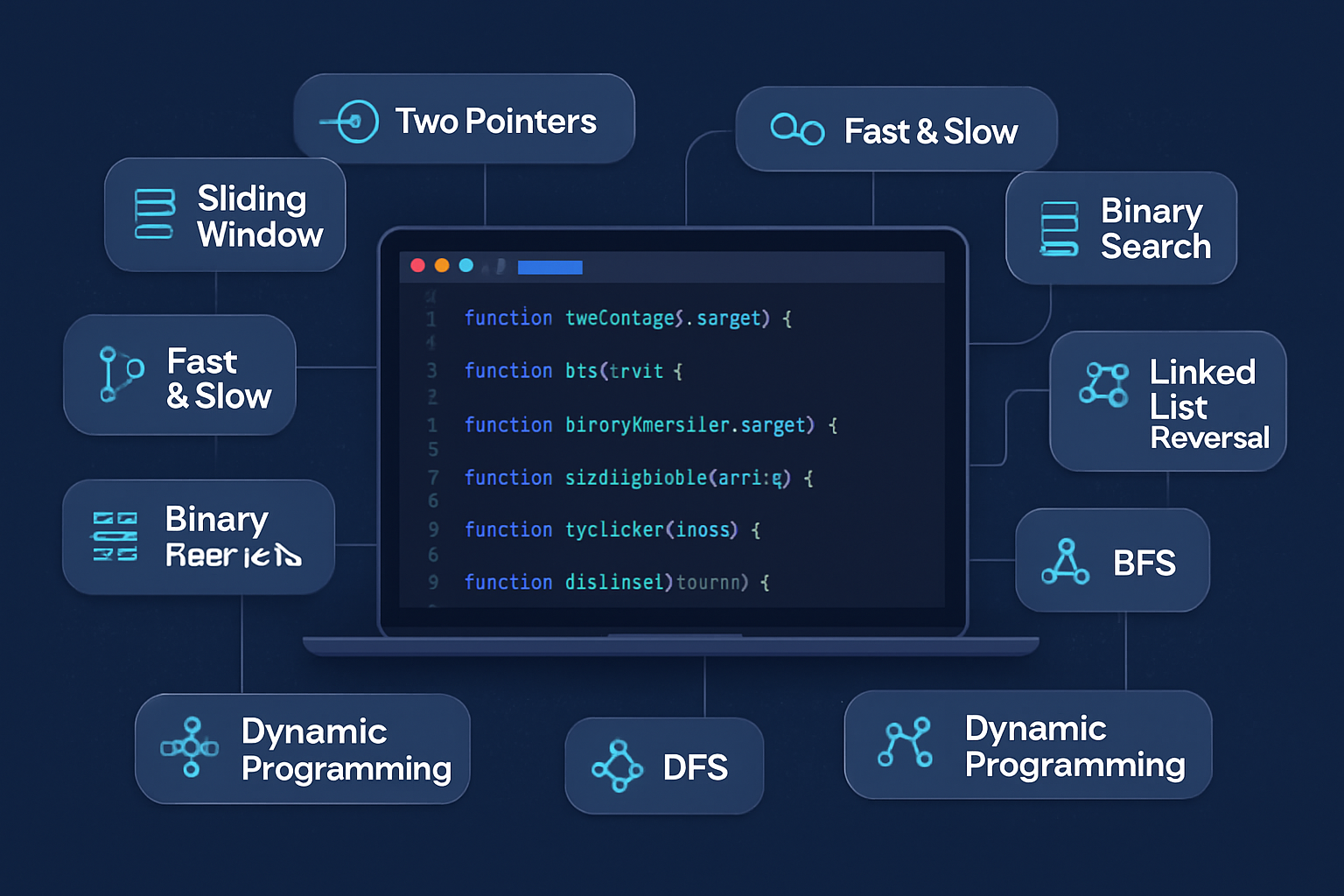· career · 6 min read
The Google JavaScript Interview Blueprint: Step-by-Step Preparation Guide
A practical, week-by-week blueprint to prepare for Google's JavaScript roles - covering algorithms, JavaScript mastery, system design, behavioral questions, and a reproducible practice schedule.

Outcome first: by following this blueprint you will convert uncertainty into a clear, measurable plan - and dramatically increase your odds of passing Google’s JavaScript interviews. You’ll gain a prioritized checklist, concrete resources to practice, a sample 12-week schedule, and high-impact strategies for coding, system design and behavioral rounds.
What this guide gives you - immediately
- A step-by-step plan you can start today.
- A focused resource list (coding practice, deep JS, system design).
- Concrete daily/weekly targets and mock-interview tactics.
Stick to the plan. Track outcomes. Improve iteratively.
Quick overview: Google’s JavaScript interview loop
Google’s process varies by role and level, but commonly includes:
- Resume screen and recruiter call.
- One or two technical phone/video screens (algorithms/data structures; live coding).
- On-site or virtual loop (4–6 interviews): coding, system design (for senior roles or full-stack/front-end/platform roles), and behavioral (Googliness + leadership).
- Hiring committee and offer decision.
See Google’s official hiring overview for general guidance: https://careers.google.com/how-we-hire/.
Step 0 - Mindset, logistics, and baseline
- Clarify the role: front-end, full-stack, or SWE with JS focus. The emphasis shifts (browser concerns vs. large-scale systems). Ask your recruiter for the loop breakdown.
- Set a measurable goal: e.g., pass 80% of mock interviews within 8 weeks.
- Build a study log: record problems solved, time taken, mistakes, and recurring themes.
A realistic baseline assessment enables realistic scheduling.
Step 1 - Algorithms & Data Structures (the foundation)
Why: Google emphasizes algorithmic thinking. Mastery here is non-negotiable.
Core topics to master:
- Arrays, strings, two pointers
- Linked lists, stacks, queues
- Trees and graphs (BFS/DFS and variants)
- Heaps and priority queues
- Hash tables/maps and sets
- Sorting and searching
- Dynamic programming (top-down + bottom-up)
- Complexity analysis and space-time tradeoffs
How to practice (high-impact):
- Daily targeted problem work. 60–90 minutes focused on one topic.
- Use a progression: easy → medium → hard within a topic.
- Quality over quantity: thoroughly analyze mistakes; re-solve after 48–72 hours.
Recommended resources:
- LeetCode - curated company tags and company-specific problems: https://leetcode.com
- “Cracking the Coding Interview” (book) for structured problem categories: https://www.crackingthecodinginterview.com/
- Practice trackers like Google Docs or Notion to log attempts.
Example micro-plan for algorithms:
- Week 1–4: Core DS (arrays, strings, hash maps, linked lists, stacks/queues, sorting)
- Week 5–8: Trees/graphs, recursion, DP basics
- Week 9–12: Advanced DP, graph variants, practice on timed interviews
Sample problem to practice (two-pointers pattern):
// Given a sorted array, return indices of two numbers that sum to target
function twoSumSorted(nums, target) {
let l = 0,
r = nums.length - 1;
while (l < r) {
const s = nums[l] + nums[r];
if (s === target) return [l, r];
if (s < target) l++;
else r--;
}
return [-1, -1];
}Practice writing clean, commented solutions on a shared editor (CoderPad / Google Docs) to mimic the interview environment.
Step 2 - JavaScript mastery (language-specific edges)
Why: Google will check that you know JavaScript idioms, pitfalls, and modern features - not just algorithms.
Topics to cover:
- ES6+ features: let/const, arrow functions, classes, modules, destructuring, spread/rest
- Asynchronous patterns: callbacks, promises, async/await, event loop
- Closures, prototypes, ‘this’ semantics
- Memory leaks and performance considerations in the browser
- Typed JS: familiarity with TypeScript is a plus for many roles
- Testing basics: Jest, DOM testing for frontend roles
High-impact exercises:
- Implement common utilities from scratch: debounce/throttle, deepClone, event emitter.
- Build a small SPA component (vanilla JS) that uses async data and updates state.
- Debugging practice: read a buggy snippet and explain the fix out loud.
Authoritative references:
- MDN Web Docs for language details: https://developer.mozilla.org/en-US/docs/Web/JavaScript
- Google JavaScript Style Guide: https://google.github.io/styleguide/jsguide.html
Step 3 - System design (front-end, full-stack & scale)
Why: For mid-to-senior levels, Google expects system thinking: design features that scale, are maintainable, and are resilient.
Areas to master for JavaScript-centric roles:
- Front-end architecture: component boundaries, state management, bundle strategy, performance optimization, caching
- Backend-for-frontend (BFF) concepts and API design
- Data flow and synchronization (optimistic updates, eventual consistency)
- Scalability patterns: caching, CDNs, rate limiting, horizontal scaling
- Observability: logging, metrics, tracing for frontend/backends
How to practice:
- Use the System Design Primer: https://github.com/donnemartin/system-design-primer. Work through examples and apply them to web app scenarios.
- Practice with frontend-focused design prompts: e.g., “Design Google Docs’ collaborative editing for many users.” Then sketch components, trade-offs, and APIs.
- Talk through latency, consistency, and cost trade-offs aloud - sketched diagrams help.
Key resource for deep systems reading: Martin Kleppmann’s “Designing Data-Intensive Applications” (conceptual foundations).
Step 4 - Behavioral interviews: ‘Googliness’ and leadership
Why: Hiring at Google evaluates role fit, collaboration, and problem-solving approach - not just code.
What they look for:
- Cognitive ability and learning agility
- Leadership and ownership
- Teamwork and execution
- Ethics and culture fit (Googliness)
Practice method:
- Use the STAR method (Situation, Task, Action, Result) to structure answers.
- Keep 10–15 stories (2–3 minutes each) covering leadership, failure, conflict, influence without authority, and high-impact results.
- Tailor stories to show measurable outcomes and what you learned.
Where to read guidance: Google’s hiring overview and structured interviewing tips: https://rework.withgoogle.com/.
Step 5 - Assemble your practice toolkit (recommended resources)
Coding practice
- LeetCode: https://leetcode.com - focus on company tags and premium mock interviews.
- HackerRank: https://www.hackerrank.com - good for timed practice.
- Frontend Interview Handbook: https://yangshun.github.io/frontend-interview-handbook/ - curated frontend topics and questions.
System design
- System Design Primer: https://github.com/donnemartin/system-design-primer
- “Designing Data-Intensive Applications” book for deep concepts.
JavaScript deep dive
- MDN Web Docs: https://developer.mozilla.org/en-US/docs/Web/JavaScript
- Google JS style guide: https://google.github.io/styleguide/jsguide.html
Mock interviews
- Pramp or Interviewing.io for free/paid mock sessions.
- Peer swapping with friends or colleagues.
Books
- Cracking the Coding Interview: https://www.crackingthecodinginterview.com/
Step 6 - Sample 12-week preparation blueprint (for full-time candidates)
Week 1–2: Baseline + basics
- Assess strengths/weaknesses with 8–12 problems across topics.
- Strengthen core JS patterns and async fundamentals.
Week 3–6: Core algorithms & language depth
- Daily problems (1–2 medium). Weekly timed mock.
- Build a small JS project demonstrating async and DOM mastery.
Week 7–9: Advanced algorithms + system design intro
- Focus on graphs, DP, and harder problems. Start 1 system design session/week.
Week 10–11: Interview simulations
- 2–3 mock interviews/week (live). Include one system design and one behavioral run.
- Review feedback and iterate.
Week 12: Polish and rest
- Light practice, revisit weak spots, finalize story bank.
- Sleep and logistics: confirm equipment, time zones, editor setup.
Daily routine (90–120 minutes typical):
- Warm-up / revisit 1 old problem (15 min)
- New problem focused on a target topic (45–60 min)
- Language-specific drill or system design reading (20–30 min)
Step 7 - Mock interviews and feedback loop
- Simulate the interview environment: shared editor, 45 minutes, speak aloud.
- Record sessions when possible and review mistakes.
- After each mock, write a short action plan: 1–2 things to fix before the next mock.
Where to get mocks:
- Interviewing.io and Pramp for structured mocks.
- Friends or ex-interviewers for realistic feedback.
On the interview day - tactical checklist
- Environment: quiet room, good microphone, charged laptop.
- Editor: know your shortcuts (VS Code / Monaco) and set font size.
- Communication: state your approach before coding. Talk about complexity and edge cases. Ask clarifying questions.
- When stuck: narrate hypotheses and trade-offs. Interviewers evaluate thought process as much as final code.
- For system design: start high-level, then dive into components, data flows, and trade-offs.
Common pitfalls and how to avoid them
- Over-optimizing prematurely: write a correct simple solution first; then optimize.
- Silence when stuck: keep the interviewer engaged with your reasoning.
- Weak behavioral stories: make them quantitative and outcome-focused.
- Ignoring language-specific pitfalls: know JS quirks and async behavior.
Final checklist before you apply / loop
- 3–5 polished coding interview solutions you can explain end-to-end.
- 8–12 behavioral stories mapped to leadership themes.
- One end-to-end system design sketch for a scalable web app.
- 8–12 live mock interviews with actionable feedback.
Closing - how you’ll know you’re ready
You’ll feel ready when your mock interview success rate climbs, you can explain solutions clearly in 10 minutes, and your design sketches show trade-offs with pros/cons. That combination - technical fluency, communication, and systems thinking - is exactly what Google looks for.
Good preparation is cumulative. Small daily wins stack into interview performance. Follow the blueprint. Track outcomes. Iterate. Repeat.
References
- Google - Hiring overview: https://careers.google.com/how-we-hire/
- LeetCode: https://leetcode.com
- System Design Primer: https://github.com/donnemartin/system-design-primer
- Frontend Interview Handbook: https://yangshun.github.io/frontend-interview-handbook/
- MDN Web Docs - JavaScript: https://developer.mozilla.org/en-US/docs/Web/JavaScript
- Google JavaScript Style Guide: https://google.github.io/styleguide/jsguide.html
- Cracking the Coding Interview: https://www.crackingthecodinginterview.com/



